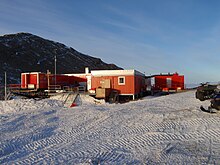Norwegian Polar Institute
| Norsk Polar Institute | |
|---|---|
 The building of the Norwegian Polar Institute in Tromsø |
|
| Carrier: | Norwegian Ministry of the Environment |
| Seat of the wearer: | Fram Center in Tromsø |
| Branch offices: | * Sverdrup research station in Ny-Ålesund on Spitsbergen
|
| Arose from: | Norges Svalbard- og Ishavsundersøkelser |
| Type of research: | Polar and marine research |
| Subjects: | Geophysics, meteorology, environmental physics, oceanography, biochemistry |
| Basic funding: | Norwegian state |
| Employee: | 110 |
The Norwegian Polar Institute ( Norwegian : Norsk Polarinstitutt ) is Norway's national polar research institution based in Tromsø . As a research institute and administrative body at the same time, it is run under the supervision of the Norwegian Ministry of the Environment and is therefore not part of the University of Tromsø . Together with other Norwegian scientific institutions, it organizes research in Norway in the Arctic and Antarctic. To do this, u. a. Expeditions carried out.
history
A predecessor of the institute was founded in 1928 by Adolf Hoel as Norges Svalbard- og Ishavsundersøkelser (abbreviated NSIU ), literally Norway's Svalbard and Arctic Ocean Studies , in Oslo. The Norwegian Polar Institute was officially founded on the basis of the NSIU in 1948 under the supervision of the Norwegian Ministry of Industry.
The Belgian polar researcher Gaston de Gerlache de Gomery named the Norsk Polarinstitutt glacier in Antarctica after the institute.
The move from Oslo to Tromsø was decided in 1993 by the Norwegian Parliament, the Storting , and took place over the course of 5 years.
Locations and infrastructure
The institute's headquarters are in the Fram Center in Tromsø , a branch in Forskningspark at UNIS on Svalbard; a total of around 110 people are employed at the Norwegian Polar Institute.
It has operated the Sverdrup research station in Ny-Ålesund on Spitsbergen since 1968 , and the year-round Troll research station in Queen Maud Land in Antarctica since 2005 . At the Zeppelin Observatory in Ny-Ålesund, gases in the atmosphere are examined.
With the Kronprins Haakon , which went into operation in 2018 , the Polar Institute operates the most modern icebreaker in the world.
Directors
- 1948–1957: Harald Ulrik Sverdrup
- 1957-1960: Anders K. Orvin
- 1960–1983: Tore Gjelsvik
- 1983-1991: Odd Rogne
- 1991–1993: Nils Are Øritsland
- 1993-2005: Olav Orheim
- 2005–2017: Jan-Gunnar Winther
- since 2017: Ole Arve Misund
